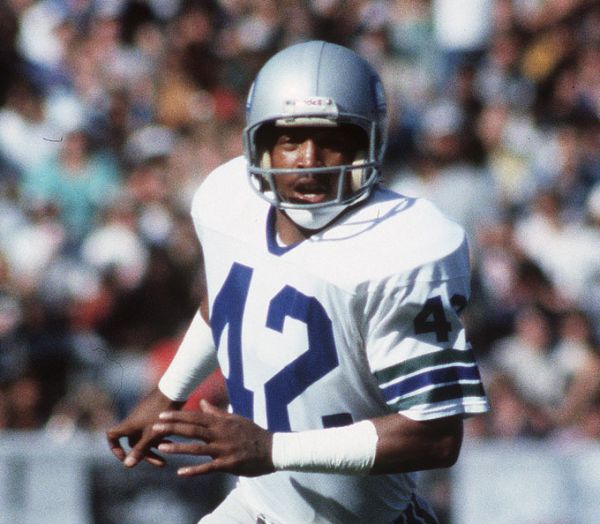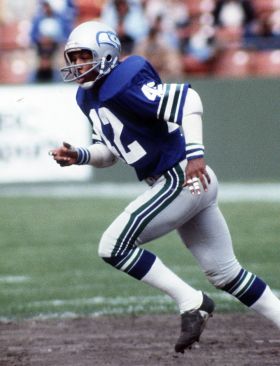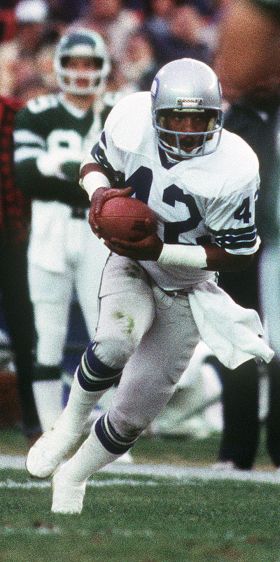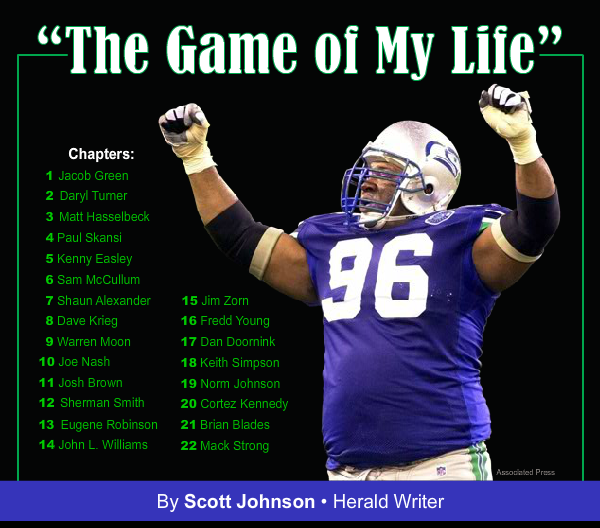Atop the desk of Keith Simpson's office at his Houston-area home, a photograph greets him each morning. The black-and-white, unframed photo is a keepsake of a time when young football players were in the prime of their lives, when they felt indestructible.
In the picture, four men celebrate arm in arm after their Seattle Seahawks recorded a dominating win and made history in the process. Two of the men, Pro Bowl safety Kenny Easley and defensive backs coach Ralph Hawkins, are beaming with pride. The others, cornerbacks Keith Simpson and Dave Brown, are too tired to even grin. Easley and Simpson hold a football under their arms, signifying the touchdowns they scored that afternoon. Brown, he has a pair of footballs, having made it to the end zone twice. And Hawkins grins like a proud father: These are my guys.
Four men, having the time of their lives.
Twenty-four years later, two of the men were gone – one taken suddenly by a heart attack and another by disease. A third had gone on to make a good life for himself, but he was still taking medication for the kidney problems that ended his NFL career prematurely.
And then there was Keith Simpson. He was one of the lucky ones. He still had his health, and the photograph to remind him of one of the greatest performances ever turned in by an NFL defense.
Keith Simpson didn't want to be like the others. The first six Simpson brothers had been stars on the football field, and so Keith -- he was the seventh of nine children, including two twin brothers who were younger -- set out to forge a path of his own as a child. Baseball was Keith Simpson's game, and his lightning-quick fastball looked like it might take his athletic career beyond what any of the others had achieved.
And yet it was football that eventually became Simpson's chose profession. After avoiding the game for most of his childhood, Keith Simpson eventually relented and gave football a try as a freshman at Corry Junior High School in Memphis. The plan was to play quarterback and show off his incredible arm strength, but coaches quickly moved Simpson to running back because he was one of the bigger kids on the freshman team.
As a freshman, Keith Simpson found time to play football, baseball, basketball and track. His teams went 65-3 that year, and Simpson was named the best athlete in the freshman class.
Like his brothers, Simpson displayed obvious skill on the gridiron. But he didn't share his siblings' undying love for the game. So after his freshman year, he quit. Only after watching his Hamilton High School get clobbered by Chattanooga-Riverside in the varsity opener of his sophomore year did Simpson decide to give it another try. An assistant coach named Melvin Ernest, who was best friends with Keith's oldest brother David, convinced Keith to give football another try.
Keith Simpson joined the Hamilton High team in time for the second game of the varsity season, playing some defensive back and middle linebacker but not getting any snaps on offense. He started out as the third-string quarterback but was eventually practicing at running back. Sitting behind a senior running back named Love Powell, Simpson waited patiently as Hamilton lost its first five games of the season.
A frustrated coaching staff eventually inserted Simpson as the starting running back, and Hamilton's fortunes changed almost overnight. He became an immediate star, helping his high school win its final six games that year. Hamilton went 11-0 during Simpson's junior year, then won the first 11 games of his senior season before seeing its 28-game winning streak snapped in the state championship game.
Every college recruiter in the country wanted the all-everything running back to suit up for his school. USC's O.J. Simpson, Kansas alumnus Gale Sayers and Oklahoma's Greg Pruitt all tried to recruit the Parade All-American to their respective schools, and yet Simpson was in no hurry to make a decision. He signed a letter-of-intent with a small school called Tennessee State in Nashville, then signed on with Oklahoma a few days later. A few days after that, he signed again, with Memphis State University.
The indecisive star running back also had a bit of a chip on his shoulder when it came to choosing a position. Recruiters wanted him to play running back, but Simpson told them he was hoping to prove he could be a big-time defensive back. All of his high school honors were as an offensive player, so Simpson believed his defensive skills were being overlooked.
To the surprise of many, he finally decided to attend Memphis State – as a defensive player.
In the end, the decision proved to be a wise one. Simpson capped off a stellar college career by being the third defensive player taken in the 1978 draft. The Seattle Seahawks took the defensive back with the ninth overall pick and let him start two games at cornerback as a rookie.
Simpson also learned from a defensive assistant coach named Ralph Hawkins, who came to the Seahawks in 1983 and quickly developed a close relationship with Simpson. He also learned some tricks from a couple veterans named Cornell Webster and Dave Brown while waiting for his chance to shine. Brown was a safety-turned-cornerback who had been with the Seahawks since their 1976 inception. A quiet, deeply religious man, Brown spent a lot of extra time in the film room and had a knack for helping younger players along.
"He was always first in the film study room, watching things, asking questions," said Kenny Easley, a safety who joined the team in 1981. "You couldn't have a better guy to serve as an example of what people should be."
Looking to put their best four defensive backs on the field, the Seahawks switched Simpson to safety in 1979, when he took over as a full-time starter. He continued to jell in a defensive backfield that also included Webster, Brown and starting free safety John Harris.
While Simpson would continue to shine in his new position at safety, it was Easley who eventually pushed him back to cornerback. A first-round pick in the 1981 draft, Easley immediately took Simpson's starting spot at strong safety. The coaches returned Simpson to his original position, where the bulked-up veteran would start 35 games over the next three seasons.
"I always hated that they drafted Kenny," Simpson said in 2008. "I didn't at first, because I had no idea what they were thinking.
"It was my second or third year in league, and getting all-pro recognition at safety. But after that, I moved back to corner. The main thing was, I had bulked up to play safety. ... I enjoyed playing cornerback, but when you bulk up, your steps are a little slower."
In what would become his final season as a starter, in 1984, Simpson played a large role in one of the most impressive defensive performances in NFL history. While the Seahawks weren't perfect in that November home game against Kansas City, they shut out the Chiefs and set an NFL record by returning four interceptions for touchdowns. As of 2008, the record had still yet to be touched.
Simpson, Easley and Brown – twice – all took interceptions back for touchdowns in a historic game that exemplified an unforgettable season.
Seahawks vs. Kansas City ChiefsNovember 4, 1984
as told by Keith SimpsonFor me, the Chiefs games were always special because I knew so many guys on the Kansas City teams. Their wide receivers coach, Richard Williamson, was my head coach at Memphis State. They had one cornerback I knew, a guy named Gary Green, and another guy named Eric Harris whom I had known since I was 15 years old. He was a year older than me, but we played on the same baseball teams, went to high school together, and then ended up going to the same college.
So it was always a big game for me when we got to play the Chiefs. It was always a rivalry, a personal rivalry for me, when we played Kansas City. And, they always had great receiving corps.
This was back at the time when every game against an AFC West team meant going against an explosive offense. It was one of those you-might-score-points-on-us-but-we're-going-to-score-on-you eras. This was back when the Chargers had Dan Fouts and Charlie Joiner and Kellen Winslow, when John Elway was coming up with Denver, when the Raiders had Marc Wilson and Todd Christensen. And the Chiefs were no different. They had all these receivers: Carlos Carson, Henry Marshall, Stephone Paige.
Of course, we had a pretty good offense, too. We had Dave Krieg and Steve Largent and Curt Warner and all those guys. But as a member of the defense, I always believed we were more of a defensive team. We had six or seven No. 1 draft choices in the lineup on defense. Our defense was very, very special that year. I think we ended up having three shutouts that year. It was pretty special.
And besides that, we knew the Chiefs pretty well. They were in our division. So we had a good idea of what they were going to do.
We knew their wide receivers because we had played against those guys for four or five years. So we got to know their habits, and they got to know ours. But the key to our defensive success was that we were very good at disguising coverages. That's something teams don't do as well now. Sometimes I'll go to a college or pro game here in my home state of Texas, and the games I go to, I can tell you what coverage they are in right away. Teams just aren't as good at disguising things. We played a lot of combination coverages back then. We would have 10 people on the line, and it would be a zone coverage. You'd swear it was a blitz, but we'd drop into a zone. The quarterback has to make a lot of adjustments, and that throws everything off. We had Jacob Green, Joe Nash and Jeff Bryant rushing the passer, and that certainly helped too. With Jacob one end and Jeff on the other end, we were pretty successful.
It's not like we totally shut the Chiefs down that day. They threw for over 400 yards. But it seemed like every time they drove into our territory, we made a play. We ended up intercepting six passes that day, and returned four of them for touchdowns. That was an NFL record, and still is.
It was one of those things where, once they got further behind, we played the pass. But it was an unusual game in that they had more passing yards than we did, and yet we won the game 45-0. The Chiefs were moving the ball that day, but we stopped them when it counted. Their first drive went into Seahawks territory before a Jacob Green sack ended that threat. Kansas City went all the way to our 13-yard line on the next drive, but Dave Brown intercepted a pass at the 5 and ran it back 95 yards for a touchdown. They were always driving down the field. It's outstanding the way things turned out.
On Kansas City's third drive, it was my turn. The Chiefs had put together another decent drive, moving the ball to our 33-yard line. I still remember the pass route, although I can't remember the receiver. It was a deep out, and I was playing further back and disguising the coverage. Their quarterback, Bill Kenney, had pressure on him at the time, and he could not see me. He ended up throwing the ball right to me, and I took it up the sideline for a 76-yard return touchdown. I was untouched going down the sideline. I've since watched it on a highlight film, and you could see Chuck Knox, our head coach, going down the sideline, cheering me on. You could see everybody running with me. I was two or three inches off the sidelines, but I knew where I was at. And I went in untouched. That gave us a 17-0 lead early in the second quarter.
What I remember just as clearly is that I had another interception earlier in the game. I got that one off Kenney, too. But one of my teammates was offsides, so that one didn't count.
Eventually, the Chiefs replaced Kenney with Todd Blackledge. But he didn't fare much better. In the second half, Dave Brown intercepted Blackledge and returned it for another touchdown. Kenny Easley added another touchdown, our fourth return touchdown, when he intercepted third-string quarterback Sandy Osiecki in the fourth quarter. We had six interceptions in all – two by Brown, two by Terry Taylor and one each by myself and Kenny Easley. Four of them went for touchdowns, which turned out to be an NFL record.
At the time, we didn't know we'd just made history. We didn't know until after the game was over with that the four interceptions were an NFL record. We had no idea. Somebody from one of the newspapers told us afterward, and then they shot a photo of us. Dave is holding two footballs, Kenny is holding one, and I'm holding one.
You can see from the photo just how exhausted we were. We were on the field most of the game. You have to remember, whenever we scored, we had to go right back on the field. We ended up being on the field for more than half of the 60 minutes that game. There were stretches where we were out there for 20, 25 plays in a row. So we were tired. But we weren't too tired. We were having a good time, playing at home. You don't get too tired at home, not when 65,000 fans are cheering you on.
I still have that black-and-white photo, to this day, sitting on my desk. I have a lot of pictures that are framed on the walls, but that picture actually sits on my desk. Every time I walk into my office and look at it, it brings back so many memories. I like looking at it because Dave is gone and Ralph Hawkins is gone, and Kenny had to retire. It's just nice to look at picture and know that we still have that record in NFL book and I happened to be part of it. But just looking at that photo, I remember what a special time it really was.
That season would go down as one of the greatest in Seahawks history. Seattle finished with a 12-4 record and advanced to the postseason for the second year in a row. Simpson finished the season with four interceptions – in a September win over Chicago, he returned another one for a touchdown – and two fumble recoveries.
But the good times would not last long, especially when it came to Simpson's career. The following year, a young cornerback named Terry Taylor whom the Seahawks had drafted in the first round of the 1984 draft became the primary starter midway through the season. Simpson saw his playing time diminish, and again he regretted the position switch that left him at cornerback.
"I always hated the idea," Simpson said in 2008, 27 years after the initial move from safety. "I felt like I could've played more years in the league if I was a safety."
Simpson played just one more season as a cornerback, but it was clear that he had lost a step. After the season, he saw the writing on the wall. Seahawks coach Chuck Knox called Simpson into his office during the 1986 training camp and officially delivered the news.
"I remember to this day walking into Chuck's office," Simpson said in 2008. "He told me, 'We're going to go in another direction.' That's the last time I saw Chuck."
It also turned out to be the last time Simpson was employed by an NFL team. He says he went to Los Angeles for a tryout with the Raiders, but that opportunity dissipated when L.A.'s veteran cornerback, Mike Davis, reported to camp after a long holdout. Simpson was offered a tryout with the Detroit Lions but turned it down.
"I said, 'I'm not going to go through this again. I'm done,'" Simpson recalled in 2008. "I sold my house in five days and moved to Houston."
Simpson had a job waiting for him in Houston, thanks to former teammate Jacob Green. He started working as a recruiter and salesman for a chemical corporation, spent some time as a sports agent and eventually landed at Federal Express, where he was still working in 2008.
Simpson rarely looked back on his football career, but because of the photo atop his desk, he can never really put the Seahawks out of mind.
"You want to cherish every moment you had with those guys," he said during a phone interview while staring at the picture on his desk. "We had something special -- to us."
In September 2004, Ralph Hawkins died suddenly after a short battle with a condition known as Pick's Disease. Simpson hadn't even known that his former coach was sick until he heard about the death.
Just over a year later, as the Seahawks were rolling through one of their most memorable seasons in franchise history, Dave Brown died unexpectedly. A workout warrior who was in tip-top shape, Brown suffered a heart attack while playing basketball with one of his sons. He was 52 years old.
"I could not believe it," Simpson said two years later, recalling his emotions.
Former teammate Kenny Easley, who heard the news while living in Virginia, was also shocked by word of Brown's death.
"It was complete devastation," Easley recalled in 2007. "This guy was in better shape than anyone -- even me, and that was almost impossible."
Two of the four men in Simpson's favorite photo were gone, and yet he still had the black and white memory that greets him each morning.
"Life is short," Simpson said in 2008. "The relationships that you've had in the past, if they're truly your friends, you should maintain those relationships. In football, you develop a bond with people. We had a special bond. Those guys, that's a special group of guys."
A group that Simpson will never forget.





